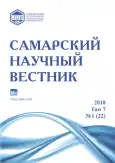Creating a new way of life for the youth in the 1920s
- Authors: Shmelev S.A.1
-
Affiliations:
- Samara National Research University
- Issue: Vol 7, No 1 (2018)
- Pages: 190-196
- Section: 07.00.00 – Historical Sciences and Archaeology
- URL: https://journals.rcsi.science/2309-4370/article/view/25370
- DOI: https://doi.org/10.17816/snv201871212
- ID: 25370
Cite item
Full Text
Abstract
This paper deals with the problem of creating a new way of life for young people in the 1920s, which was of great importance in the work of the Bolshevik Party for the communist education of the younger generation. Creating a new way of life of the youth had its own peculiarities and was aimed at overcoming the traditional forms of individualistic way of life, educating the communist worldview, developing collective forms of relationships among the younger generation, involving young people in the struggle against religious and other everyday remnants. The party sought to establish control and manage youth through Komsomol organizations. The work of the Komsomol reflected all the contradictions inherent in the transitional era of the 1920s. The paper contains main forms and methods of practical work that created a new life among young people aimed at changing everyday relationships between young men and girls; it describes mass work for the youth through clubs, sports and dance clubs, cinematography; mobilization of young people to combat domestic remnants; creating new cultural and everyday traditions and their distribution through the youth to society as a whole.
Keywords
Full Text
##article.viewOnOriginalSite##About the authors
Sergey Anatolyevich Shmelev
Samara National Research University
Author for correspondence.
Email: sershmel@mail.ru
researcher of Aviation and Cosmonautics Museum
Russian Federation, SamaraReferences
- КПСС в резолюциях и решениях съездов, конференций и пленумов ЦК (1898-1986). М.: Политиздат. 1983. Т. 2. 606 с.
- Российский государственный архив социально-политической истории (РГАСПИ). Ф. М-37. Оп. 5. Д. 10. V Всесоюзная конференция ВЛКСМ 24-31 марта 1927 г. Стенографический отчет. Молодая гвардия. Москва. Ленинград. 1927 г. 440 с.
- РГАСПИ. Ф. М-1. Оп. 23. Д. 495.
- РГАСПИ. Ф. 613. Оп. 1. Д. 45.
- РГАСПИ. Ф. М-1. Оп. 23. Д. 584.
- РГАСПИ. Ф. М-1. Оп. 23. Д. 859.
- РГАСПИ. Ф. М-1. Оп. 23. Д. 740.
- Багаратян Т. Комсомол и работа среди девушек // Коммунистка. 1925. № 10. С. 28-32.
- Кириллов С. Девушка в комсомоле // Коммунистка. 1928. № 9. С. 27-32.
- Самарский областной государственный архив социально-политической истории (СОГАСПИ). Ф. 53. Оп. 1. Д. 403.
- СОГАСПИ. Ф. 53. Оп. 1. Д. 418.
- РГАСПИ. Ф. М-1. Оп. 23. Д. 580.
- Вопросы комсомольской работы. О девушках // Голос Молодежи. 04.07.1924. № 94. С. 4.
- Либензон Л. О пудре и жизни во всех ее видах // Коммуна. 02.03.1928. № 53 (2764). С. 2.
- Государственный архив новейшей истории Ульяновской области (ГАНИУО). Ф. 43. Оп. 1. Д. 272.
- ГАНИУО. Ф. 1. Оп. 1. Д. 1487.
- Смидович С. Изжить болезненные явления в комсомоле // Коммунистка. 1929. № 16. С. 11-16.
- ГАНИУО. Ф. 57а. Оп. 2. Д. 125. Табарданова Ю.В. Воспоминания о работе на Машиностроительном заводе в первые годы Советской власти. Рукопись.
- КПСС в резолюциях и решениях съездов, конференций и пленумов ЦК (1898-1986). М.: Политиздат. 1983. Т. 3. 606 с.
- СОГАСПИ. Ф. 53. Оп. 1. Д. 345.
- СОГАСПИ. Ф. 53. Оп. 1. Д. 281.
- СОГАСПИ. Ф. 1. Оп. 1. Д. 1386.
- Государственный архив Пензенской области (ГАПО). Ф. 39. Оп. 1. Д. 16.
- РГАСПИ. Ф. М-6. Оп. 8. Д. 10. VIII съезд ВЛКСМ 5-16 мая 1928 г. Стенографический отчет. Изд. Молодая гвардия. 1928 г. 602 с.
- Государственный архив Российской Федерации (ГАРФ). Ф. Р-7576. Оп. 3 Д. 4.
- РГАСПИ. Ф. М-1. Оп. 5. Д. 9.
- РГАСПИ. Ф. М-1. Оп. 23. Д. 389.
Supplementary files






